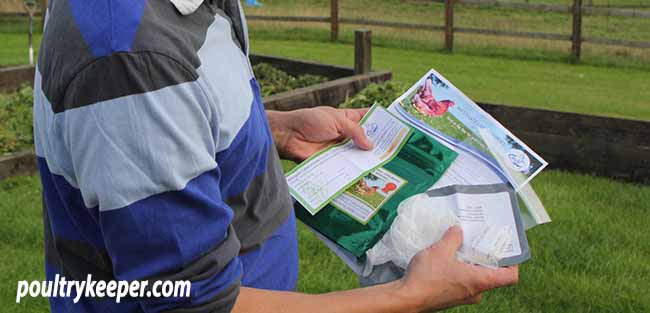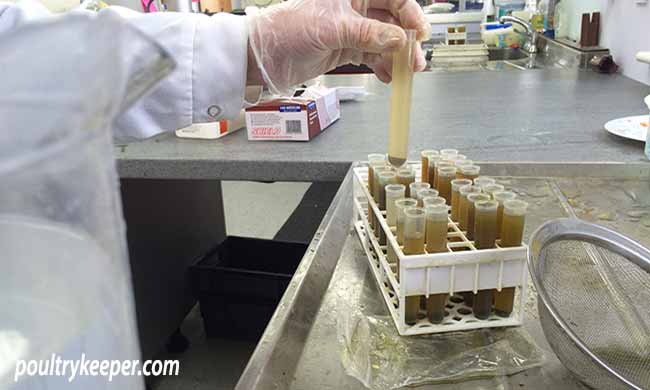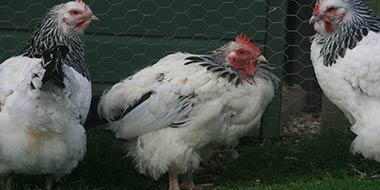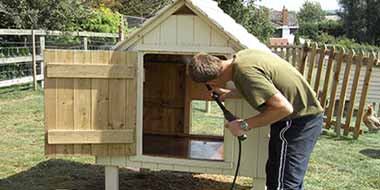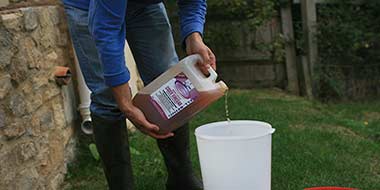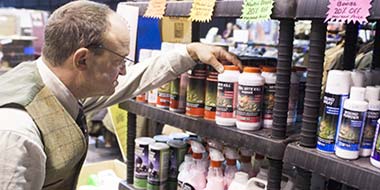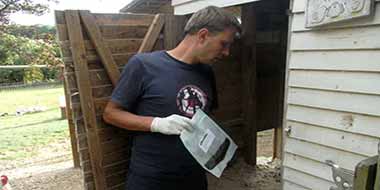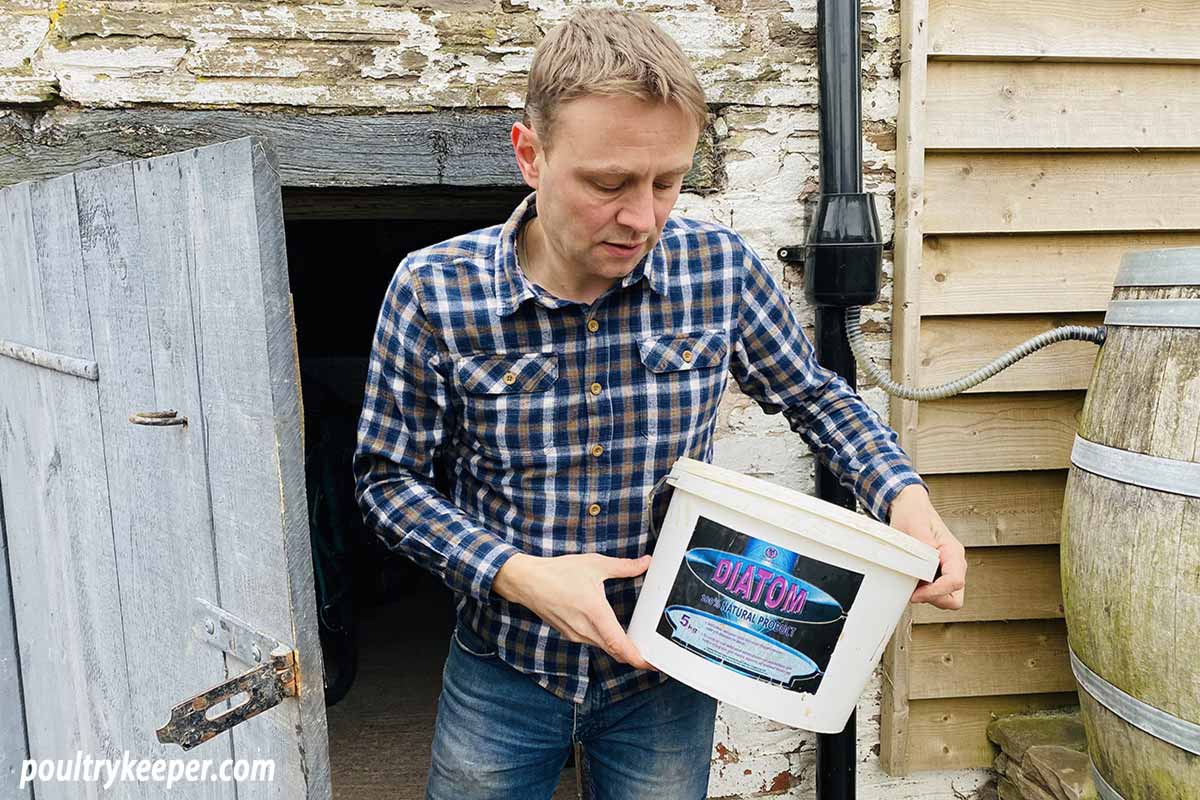
Diatomaceous
Earth
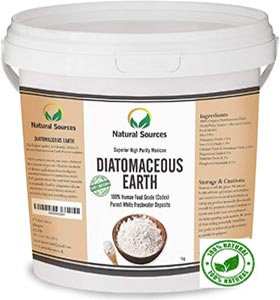
Is diatomaceous earth for chickens all it’s cracked up to be? This natural substance gets a lot of good publicity within the poultry community; however, there have been concerns about safety in recent years regarding respiratory problems.
I am sceptical about products that appear to be a miracle cure-all, but I have seen some good results using diatomaceous earth.
In this article, I look at some of the uses of diatomaceous earth for chickens and look for scientific research to support these uses.
What is diatomaceous earth for chickens?
Diatomaceous earth is a natural product formed from the fossilised micro-skeleton remains of microscopic diatoms, hard-shelled algae. These algae were created millions of years ago, and are usually sourced in freshwater, then oven-dried and ground down to an off-white coloured powder.
Diatomaceous earth composition is typically 80–90% silica, with 2-3% alumina from clay minerals and 0.5–2% iron oxide.
Food grade diatomaceous earth contains amorphous silica with very little crystalline silica (this is important, I’ll come back to it). Diatomaceous earth for chickens is food grade diatomaceous earth.
Diatomaceous earth has a slightly abrasive feel to it. We can find it in toothpaste, metal polishes, various filters (for example, in swimming pool filters), and insect control in grain storage. It is an excellent absorbent of liquids, and as well as being found in numerous industrial fillers and coatings, it’s a common ingredient in cat litter.
Is diatomaceous earth safe for chickens?
Since diatomaceous earth is organic, most people will assume it is perfectly safe. The dangers I have found is us or our chickens breathing in the dust and the composition/type of diatomaceous earth we buy.
The most significant risk is while dusting it around poultry houses or onto our birds.
Dust inhalation
Firstly, breathing in any dust/particles isn’t recommended. We can take some precautions, and I feel there’s a balance between using it with care (for a short time with limited exposure) and the benefit of (say) removing a parasite.
It is an organic product that doesn’t require chemicals to go into the bloodstream, and there is no egg withdrawal period.
These days, I wear a dust mask or suitable face covering when using DE. I protect my chickens by covering their heads loosely with a cloth (I use an old towel) whilst dusting between their feathers.

Food grade diatomaceous earth
Secondly, diatomaceous earth for chickens is “food grade”. It contains amorphous silica. There are also products for other purposes. Many are heat-treated and contain crystalline silica, which isn’t recommended for poultry.
It is also a sensible precaution to check the type of diatomaceous earth you are buying is suitable for chickens.
Some other types of DE contain high quantities of silica, which are linked to respiratory problems. It would be best if you avoided these. Particles of crystalline silica can stick to the lungs when inhaled to cause a respiratory disease called silicosis.
For example, swimming pools can use DE, and there is a high crystalline silica content in swimming pool grade DE. Look for products that say “food grade” or buy products specifically for use with poultry.
If you are unsure, the label may say “amorphous silica” or “less than (a certain percentage of) crystalline silica” on these products. Look for products with a LOW percentage of crystalline silica, ideally 1% or less.
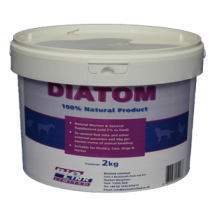
Using diatomaceous earth for chickens
Diatomaceous earth uses for chickens are primarily concerning parasite prevention. I have had success using it inside chicken coops in my battle with red mites and have used it (dusted carefully) into the feathers for treating lice. There have been some positive results in studies when treating hens with Northern fowl mite.
I haven’t been able to verify whether it is an effective treatment to help control internal parasites (worms) in my hens, and I found no conclusive studies to suggest it works.
Diatomaceous earth is also known to contain beneficial trace minerals. Some studies suggest it can help increase feed efficiency (feed conversion) and egg size, so even if it isn’t controlling worms, I believe it is a helpful food additive for our hens.
Diatomaceous earth for chicken mites
I have used diatomaceous earth for chicken mites and lice for several years and have found it to work well. They don’t drop dead immediately, it can take a few treatments, but I prefer to use this slightly slower, natural approach if my chickens are not in any immediate danger of becoming ill from their unwanted hosts.
Diatomaceous earth is 100% natural, and there is no egg withdrawal period as with chemical alternatives such as ivermectin.
Red mite
Bad infestations
If you have a coop full of red mite, I cannot recommend diatomaceous earth as a solution. Your chickens will be suffering, and will quickly become anaemic, stop laying and in some cases, die.
You will need more drastic action to bring their numbers down faster to protect your hens before using diatomaceous earth around the coop.
I clean out the chicken house and use Poultry Shield (a safe disinfectant) to get rid of most red mites; then, I rinse it out with the hosepipe.
Once the coop is dry, I use diatomaceous earth in the cracks and on perch ends, killing more mites as they try to reach my hens at night.
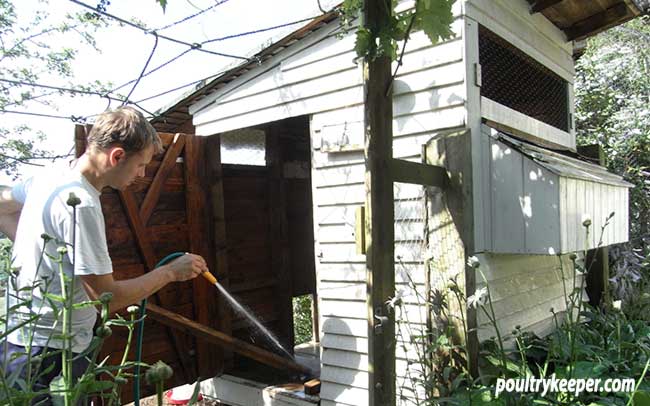
If you would like to see how I do this, then read: How to get rid of a Red Mite Infestation for more information.
Lice
From time to time, my hens end up with lice, and I have found dusting hens with diatomaceous earth and providing them with a diatomaceous earth dust bath (more on these two things shortly) works well.
I will usually need to dust each hen, mostly around the bottom (Lice lay their eggs at the base of feather shafts near the bottom), then provide them with a dust bath. If they don’t use the dust bath much, I often need to re-treat them again, although I usually find one good dusting does the trick.
Northern fowl mite
A study by Bennett et al. 2011 that took two different types of hybrid hens, infested with Northern fowl mite and dusted them with diatomaceous earth, found they had significantly fewer mites than control hens that they dusted with sand.
While I haven’t had an infection of Northern fowl mites in my hens to try it for myself, I have seen positive results using DE to rid chickens of lice, so I think it is a credible treatment for moderate infections.
It won’t be an immediate fix; it would need repeated treatments for at least a few days. I would also provide the hens with a dust bath containing DE for them to treat themselves (more on dust baths containing diatomaceous earth coming up).
How do I use diatomaceous earth for chicken mites?
Considering most other dusting powders contain diatomaceous earth as the main ingredient (and usually cost more), it is a product I always keep in stock.
I use diatomaceous earth in three ways: In the chicken coop for red mites, dusted between my hen’s feathers for lice and in dust baths.
As already mentioned at the beginning of this article, you and your hens should not breathe the powder, so take precautions whilst doing this.
1. In the chicken coop
During the red mite season, I use diatomaceous earth in my chicken houses after cleaning them out. I add a sprinkling of powder onto the coop’s floor before adding fresh bedding, and I will rub some into the (wooden) perches and dust perch ends.
If I have a red mite problem, I will use it after cleaning the coop out, as I described in ‘Bad infestations’ above.

2. Applying diatomaceous earth to chickens
To apply diatomaceous earth to a hen, you will need to secure her. If she starts flapping around, you will end up with powder flying everywhere.
A hen is calmer if she faces you. Keep your left hand flat and hold it underneath her to support her weight. Keep your fingers apart to accommodate her legs.
Her head can go underneath your arm, so she faces behind you. If she flaps, use your right hand over the top of her wings to secure and calm her.
Once she is secure, I sit down to use my legs and knees to support her. I place her legs between my knees to hold her securely and can now use my left hand across the top of her wings if she flaps.
My right hand is free to part her feathers, and I can apply diatomaceous earth carefully in between onto the skin.



3. Diatomaceous earth dust bath
If my chickens have mites or lice, I will mix some diatomaceous earth into my chickens’ dust bath. I use potting compost or play pit sand with a sprinkle of diatomaceous earth on top, then mix it in well. It’s not incredibly dusty; it sticks well to the compost or sand, which is probably ever so slightly damp.
Whilst adding diatomaceous earth to dust baths increases the chance of respiratory problems, if left to their own devices, they will find a dusty spot in the garden and create clouds of dust anyway.
On balance, considering they have a limited time using a diatomaceous earth dust bath, and it helps them rid themselves of parasites, I feel it is worthwhile.
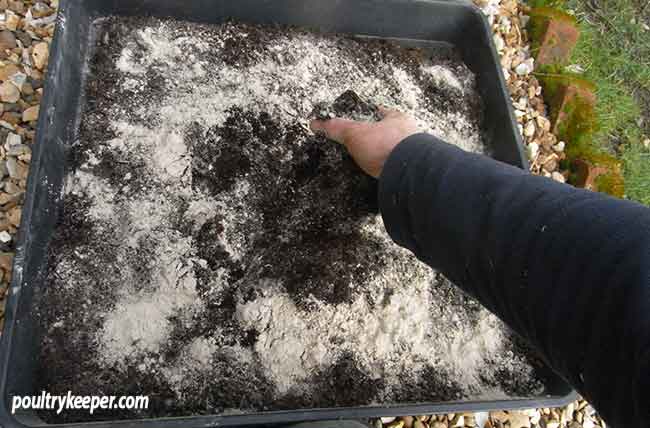
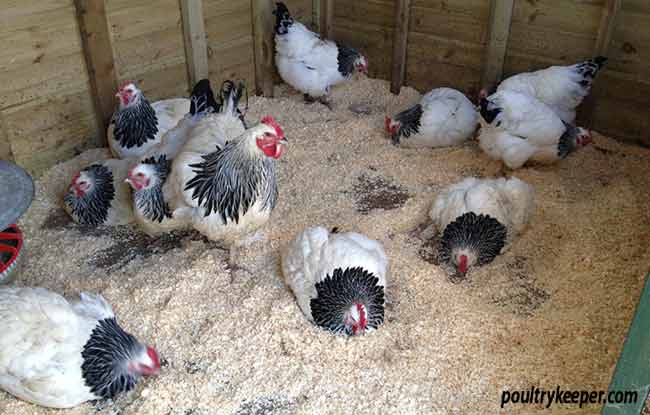
Sometimes, my hens will go into a clean chicken house and create a dust bath in the wood shavings in which I have added a little diatomaceous earth, which has the same effect.
I have some chickens that are over 12 years old, and they haven’t given up having a dust bath from time to time when they need it!
Worming chickens with diatomaceous earth
Worming chickens with diatomaceous earth is something many websites suggest. Since I am unable to perform these types of tests at home on my hens, I was hoping to find some research that told me it was an effective treatment to help control internal parasites (worms) in chickens, but I read several papers, and I cannot say it helps.
One study (Bennett et al. 2011) says it can be an effective treatment to help control parasites in poultry, and other websites reference this paper. Still, I feel this is misinterpreted because this study also found no effect on a group of hens considered a more parasite-resistant breed.
So far, I have found no conclusive studies for worming chickens with diatomaceous earth.
Even though I’m not convinced that diatomaceous earth can help control worms, it contains beneficial trace minerals, so I believe it is a helpful food additive for our hens anyway.
As with other holistic methods I use (apple cider vinegar, garlic, Verm-X), I see no harm in using diatomaceous earth in this way. I suggest you combine it with a periodic worm egg count to verify that it’s working.
Related Chicken Health Articles:
- Garlic for Chickens - I have seen positive results feeding garlic to my chickens.
- Apple Cider Vinegar for Chickens - A popular, cost effective tonic to add to your chicken's water.
- Verm-X for Chickens - I have been using Verm-X as part of a holistic approach to keeping my chickens healthy.
Although I don’t believe in worming chickens with chemical wormers indiscriminately, I wouldn’t hesitate to suggest worming chickens based on a high faecal egg (worm) count because worms can do an awful lot of damage if left unchecked. Why take the risk?
Getting A
Worm Egg Count
Using a worm count kit is relatively straightforward. There are gloves, a collection bag for samples and a pre-paid envelope. The worm count takes place in a lab under a microscope, and the result is returned by email advising you of the number of eggs and whether you need to worm your chickens.
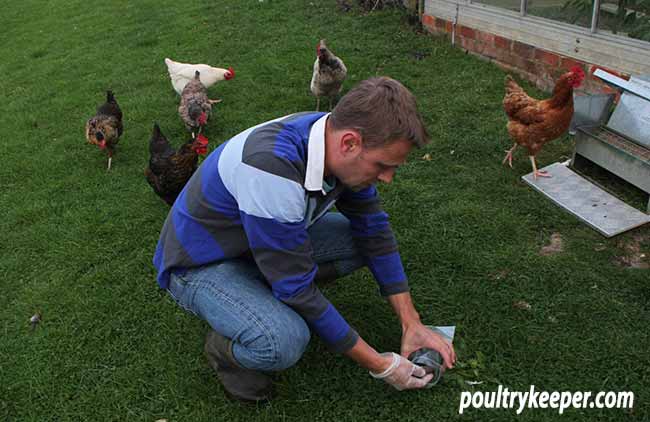
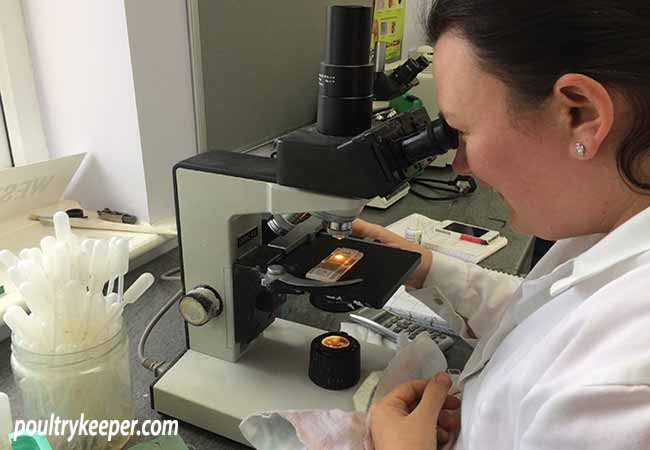
Feeding chickens diatomaceous earth
Diatomaceous earth is approximately 80% silica, a dietary mineral. It is also known to contain beneficial trace minerals such as alumina from clay minerals and iron oxide. It is used in agricultural grain storage to prevent caking and to stop parasites that can eat the grain, so in some ways, I wonder whether our hens have been eating small amounts of diatomaceous earth in their feed anyway?
I couldn’t find out, but if you know anything about this, please leave me a comment.
Studies have claimed it can increase feed efficiency and egg production (Eshleman, 1966), and feeding DE significantly improved feed conversion (Mathis and McDougald 1995) in broilers. The same study I mentioned earlier by Bennett et al. found that it could enhance egg production of organically raised, free-range laying hens.
I found other references to studies where the quantity of yolk and albumen (the egg white) increased, so I believe diatomaceous earth in chicken feed can benefit our hens.
We can mix diatomaceous earth into chicken feed. How much should you add? It’s an organic, natural product, so there’s no official dose, and I don’t think you need to be too precise, but most suppliers suggest no more than 5%. That’s 50 grams per Kilogram, 1Kg into a 20Kg bag.
I think that’s quite a lot, so I tend to add about a cup to 20Kg bag of feed, which is about 500 grams or 2.5% for my cup.
Some people like to use a little cod liver oil (which also contains useful vitamins for chickens) to help it stick.
Mix up a paste using a small amount of cod liver oil, then mix it in with your chickens’ feed.
Where to buy diatomaceous earth
Agricultural stores and online poultry suppliers sell diatomaceous earth for chickens. You can usually purchase it in tubs, but I also like the shaker tubs since they are easier to use. I have had the same shaker for many years that I refill from a larger 5Kg tub.
Diatom can be bought online here in small puffer bottles and 2Kg or 5Kg tubs.
Conclusions
I believe diatomaceous earth can contribute towards my chickens’ overall health and be part of a long-term holistic approach to keeping chickens healthy and parasite free, but only when they have proper management, feeding and day-to-day care.
My conclusions from personal experience using diatomaceous earth (since 1998 or thereabouts) and reading the scientific research papers that have been published are as follows:
- 100% Natural, suitable for use in organic systems.
- Must not be breathed in: follow manufacturer's advice and take precautions such as wearing a dust mask.
- Safe for your chickens if they don't breathe it in. Use a loose cloth over their heads when dusting them, take care with dust baths.
- Will remove lice (with a few treatments).
- Very useful dusting powder for red mite in the chicken coop.
- Likely to remove Northern fowl mite.
- Unlikely to help to prevent poultry worms.
- A useful feed additive.
- A little can be mixed into dust baths when needed, but it shouldn't be breathed in by hens, so don't make it too dusty.

